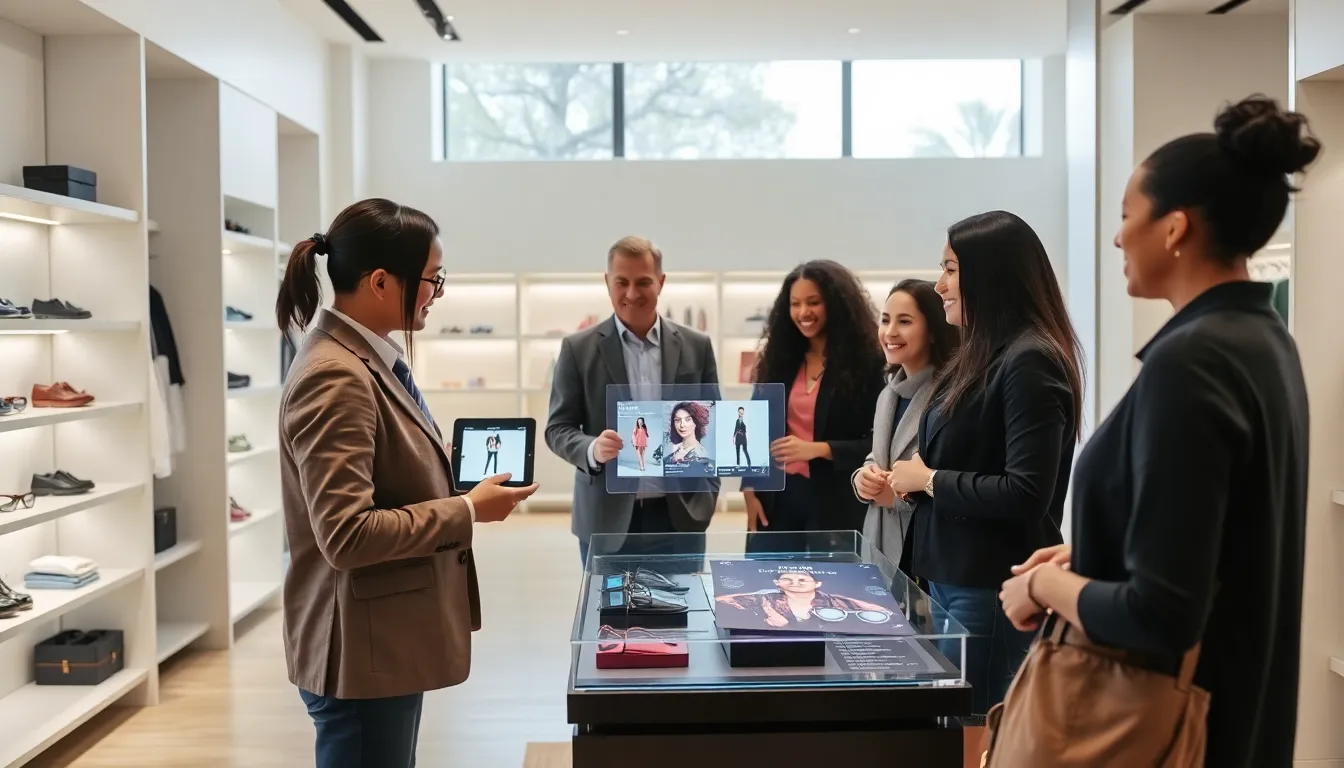Imagine trying on shoes without ever leaving your couch. Or perhaps visualizing that outrageous piece of furniture in your living room before making the leap. Enter augmented reality, the tech superhero of the retail world, combining the digital realm with our physical environment. As businesses jump on the augmented reality train, it’s clear this innovation is revolutionizing sales strategies and transforming experiences in ways we never thought possible. Let’s jump into how augmented reality is reshaping retail and what that means for the future of shopping.
Table of Contents
ToggleUnderstanding Augmented Reality in Sales

To grasp the full impact of augmented reality in sales, one must first understand what augmented reality (AR) entails. At its core, AR overlays digital information onto the real world, enhancing what the user sees, hears, and interacts with. Unlike virtual reality, which immerses users in a completely digital environment, AR allows users to experience a blend of the two worlds. Think of Pokemon Go, where players capture creatures in their neighborhood. This technology can be a significant game-changer for retailers, offering innovative ways to engage customers and enhance their shopping experience. In a retail context, AR can transform product displays, allow for virtual try-ons, and even create interactive advertisements that draw customers in like moths to a flame.
Benefits of Augmented Reality in Retail
The advantages of incorporating augmented reality into retail are nothing short of compelling. Firstly, AR provides an immersive shopping experience that keeps customers engaged. Imagine browsing a store and pulling up additional information about a product with just a glance. This added layer of information builds customer confidence as they make decisions. Also, studies show that customers are more likely to purchase products they’ve interacted with through AR, leading to higher conversion rates. Also, there’s the cool factor, brands that use AR can position themselves as cutting-edge, attracting tech-savvy shoppers. Finally, AR reduces the return rates. By allowing customers to visualize products in their own spaces or even try on clothing virtually, the likelihood of them making a return diminishes significantly.
So, whether it’s about saving time, boosting engagement, or providing a one-of-a-kind shopping experience, the benefits of AR are clear and compelling.
Key Applications of Augmented Reality Sales
The world of augmented reality sales is vast, with numerous applications emerging every day. Retailers are harnessing this technology in a variety of innovative ways.
Virtual Try-Ons
One of the most prominent applications is virtual try-ons. Beauty brands like Sephora and tech giants like Apple allow users to see how makeup or gadgets will look in real life before they commit to a purchase. Customers can simply use their devices to produce a realistic image of themselves wearing a new lipstick shade or checking if those sunglasses suit their face shape.
Interactive Store Displays
Imagine walking into a store where product information, tutorials, and discounts pop up on your screen just by pointing your smartphone at an item. Interactive displays can deliver personalized information, turning a simple shopping journey into a tailored experience. Nike and IKEA are paving the way by allowing customers to visualize products right in their own homes.
Enhanced Product Stories
AR also has substantial potential in storytelling. Brands can create immersive narratives around products that deeply engage customers. A simple can of soda could unveil its journey from the farm to your table, making the shopping experience more captivating. This connection can create brand loyalty and encourage customers to share their unique experiences across social media.
Implementing Augmented Reality in Your Sales Strategy
Integrating augmented reality into a sales strategy may seem daunting, but breaking it down can simplify the process.
Assess Your Audience
Start by understanding your target audience. Determine whether your customer base is enthusiastic about technology or if they prefer traditional shopping methods. This insight will influence the design and complexity of your AR features.
Define Objectives
Set clear goals for what you want to achieve with AR. Are you aiming for higher conversion rates, improved customer engagement, or enhanced brand awareness? Having precise metrics will guide your implementation.
Choose the Right Tools
There are various AR development platforms available, such as ARKit for iOS and ARCore for Android. Collaborate with a tech partner or consider a no-code AR building solution if you lack technical expertise.
Start Small
A successful AR initiative doesn’t need to be expansive right off the bat. Start with smaller projects like a virtual try-on feature or an interactive catalog before rolling out extensive experiences. Gather feedback to refine the offering continuously.
Challenges and Considerations in Augmented Reality Sales
Even though its many advantages, integrating augmented reality into sales comes with its fair share of challenges. Costs can quickly escalate, particularly if substantial investments are required for custom development or branding. Not every customers may feel comfortable adopting AR technology, which poses a risk if businesses invest heavily without understanding their audience’s willingness to engage. Also, AR experiences must be seamless: glitches or bugs can frustrate users and lead to negative perceptions of the brand.
Privacy concerns may also arise. Striking a balance between engaging customers and maintaining respectful use of their data is vital. Retailers must be transparent and responsible when implementing AR technologies.
Future Trends in Augmented Reality Sales
The future of augmented reality in sales appears bright and full of potential. As technology continues to evolve, we can expect more seamless integrations into shopping experiences.
Advancements in Device Compatibility
With the rise of smartphones and smart glasses, AR experiences may become even more accessible. It’s possible that in the near future, customers will walk into stores with AR glasses, instantly receiving information about products without even pulling out their phones.
Artificial Intelligence Integration
Also, combining AR with artificial intelligence could result in highly personalized shopping experiences. Imagine an AR app that learns your preferences and presents tailored recommendations as you browse. Such integration could revolutionize how consumers interact with brands.


